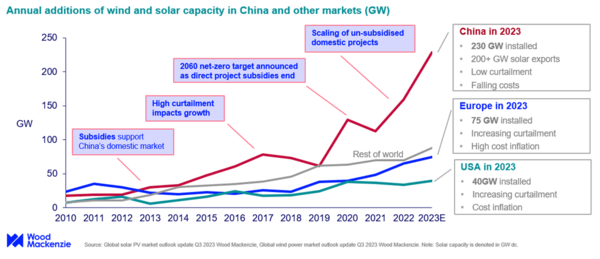News Release from windfair.net
Wind Industry Profile of
China is romping away in the race for renewables
Direct state subsidies for the expansion of renewables? Abolished. And yet this year, the expansion of clean energies in China is booming more than ever. While Europe and the U.S. are still arguing over and over again about how much support the renewable energy industry needs, China is already one step ahead.
This is impressively demonstrated by the latest report 'How China became the global renewables leader' by Wood Mackenzie. Investments totalling 140 billion US dollars and a massive expansion of the domestic market are ensuring China's lead, which will result in a new record of 230 GW installations this year. This is more than double the number of installations in the US and Europe combined.
"China announced its 2060 carbon neutral target in 2020 and since then has been quietly re-organising the entire power sector to support rapid electrification and expansion of renewables. As we came out of COVID-19 lockdowns this year, it’s impressive to see how far ahead China really is. While some other markets are moderating renewables targets, China has pushed up its 2025 wind and solar outlook by 43% or 380 GW in just a couple of years," explains Alex Whitworth, Vice President, Head of Asia Pacific Power and Renewables research at Wood Mackenzie.

China will end 2023 with a new record in the expansion of renewable energies (Graphic: Wood Mackenzie)
While the Chinese energy transition has often failed in recent years due to the lack of or slow expansion of the electricity grids that could transport the clean electricity from sometimes remote regions to the large conurbations and industrial centres, China has also learned in this area and is investing heavily in grid expansion. China has earmarked grid investments totalling 455 billion US dollars for the period 2021-2025, which is 60 % more than in the previous ten years, as Wood Mackenzie explains. This includes long-distance transmission lines of more than 1,000 kilometres, which have enabled the development of more than 100 GW of renewable energy in the country's interior.
Despite all the praise, China is still far from being a model state. Coal still accounts for around 55% of electricity generation - far more than in other industrialised nations such as the USA (2022: 20 %) or Germany (2022: 32.8 %) or a model country such as Denmark, where 55% of electricity came from wind energy alone last year. However, the proportion of coal in China has already fallen by 10 % in the last five years.
And even the often criticised 200 GW pipeline of coal-fired power plants now looks more diverse, as a fleet of more than 100 GW of flexible power plants has been created that burn less coal and are designed to be ramped up to support fluctuating renewable energies.
This has given China a locational advantage that other industrialised nations may find difficult to crack. "China’s end-user power prices are less than half those in Europe or Australia and this supports a strong competitive edge in global trade. The China power market is now larger than that of Europe and the US combined, so if it can succeed in transitioning to a high share of intermittent renewables while maintaining stable prices, that would be an historic achievement,” says Whitworth from Wood Mackenzie. It was Russia's war against Ukraine that led other countries, such as the EU states, to place a greater focus on domestic production in future and to fight against the superiority of the Far East. However, competing subsidy mechanisms such as the EU's Green Deal and the US's Inflation Reduction Act continue to ensure a fierce battle for industrial locations. This could mean China comes out at the top, tempting with low energy prices.

China's metropolises, here the city of Chongqing with a population of 32 million, require a lot of electricity (Image: Pixabay)
On the occasion of the upcoming world climate summit COP28, IEA Executive Director Fatih Birol mentions another point that needs to be improved: "The world’s climate ambitions hinge on our ability to make the global energy system much more efficient. If governments want to keep the 1.5 °C goal within reach while supporting energy security, doubling energy efficiency progress this decade is critical."
So there is still a lot for China to do to further advance the energy transition.
- Author:
- Katrin Radtke
- Email:
- press@windfair.net
- Keywords:
- China, USA, EU, Germany, renewable energy, coal, grid, installation, record, resources, wind, solar, GW, capacity

























